ENGLISH-FON (Fundamental Of Nursing)-GNM-UNIT -2 C0MMUNICATION (Part : 2)
Communication
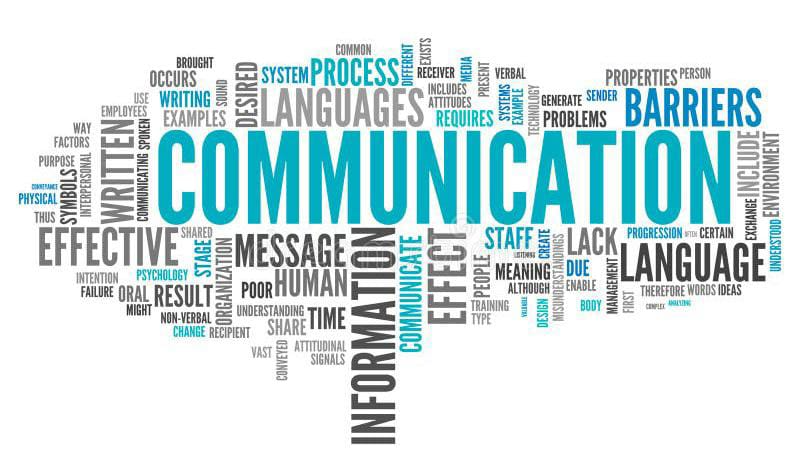
- The word communication is derived from the Latin word ‘communicare’ which means ‘to share’ or ‘to impart’ or ‘to participate’ as well as ‘common’.
- Communication means transmission of information.
- Communication is a process in which information, ideas, thoughts and feelings are exchanged between individuals or groups. In which verbal and non-verbal methods are used.
- Communication is important for expressing thoughts, understanding others and building relationships.
- Communication is a vehicle for establishing a therapeutic relationship with the patient.
Definition of communication
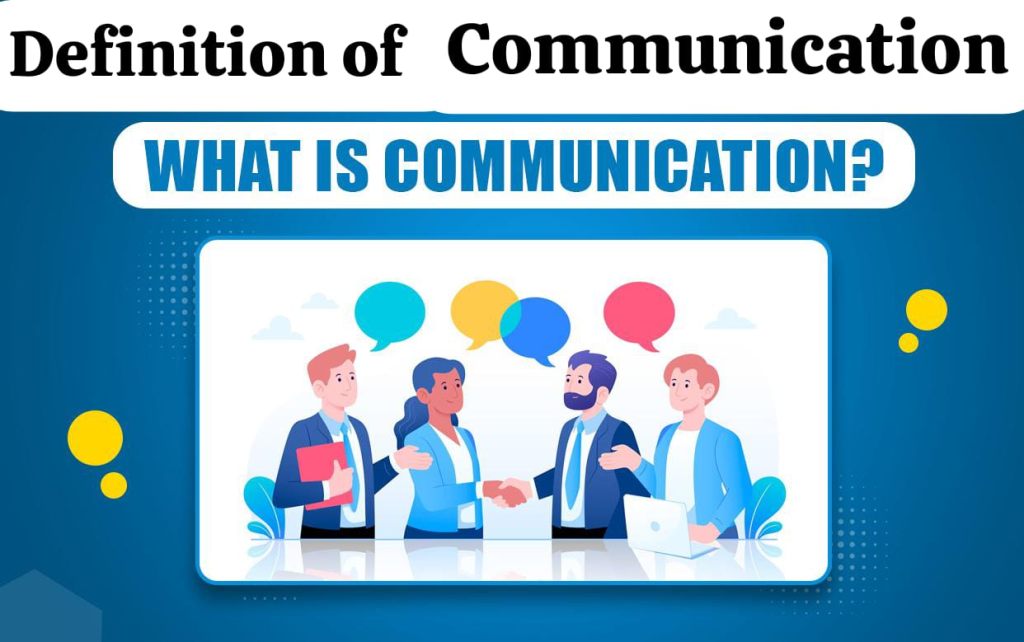
- Communication is a process in which individuals exchange information through a common system.
- Thoughts, opinions and information exchanged through speech, writing and sign are known as communication.
- Communication means exchanging ideas, facts, opinions and emotions between two or more people.
- Communication is a process in which thoughts, feelings, facts and other information are transmitted or exchanged between individuals or groups. In which verbal and nonverbal methods are used.
Purpose of communication
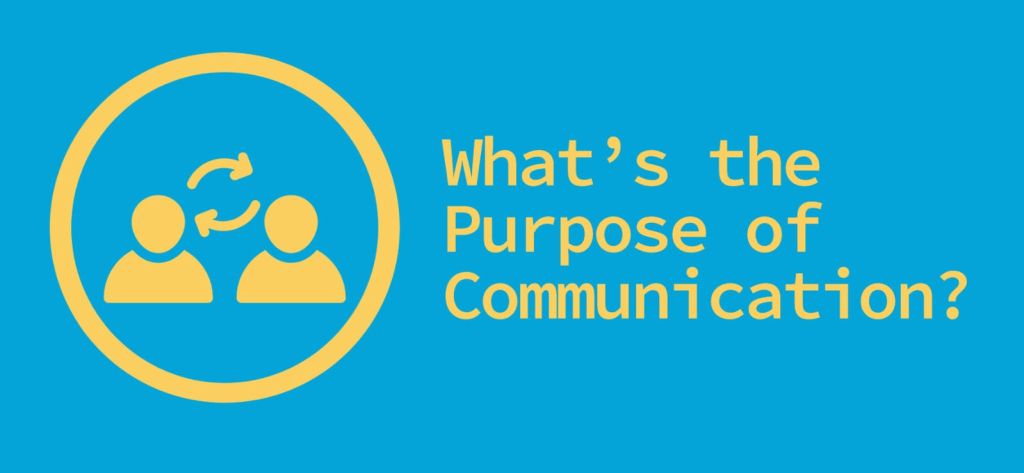
- To exchange or transfer information.
- To build relationships.
- To identify, analyze, and solve problems.
- To interact socially.
- To coordinate with other organizations.
- To encourage participation in decision-making.
Elements of communication
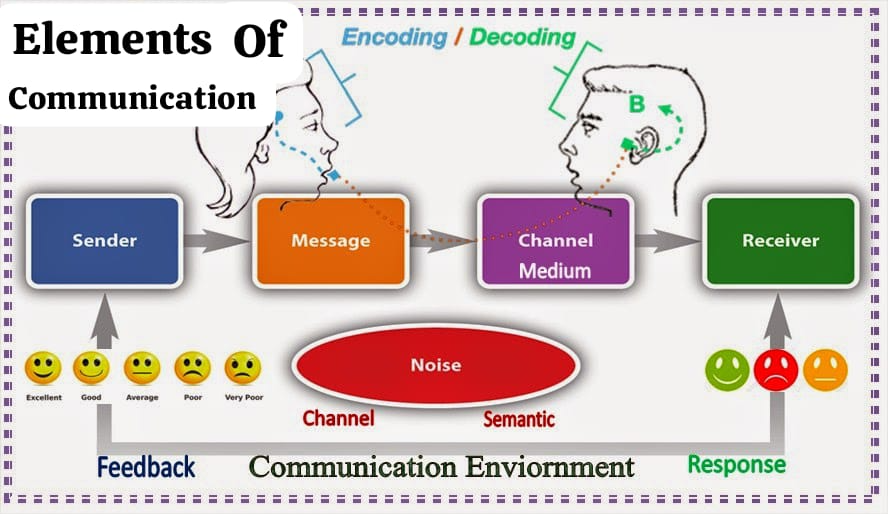
- David Berlow has given the ‘SMCR’ model for communication, in which the elements of communication are well explained.

- S – Source
- M– Message
- C – Channel
- R – Receiver
- The elements for communication are as follows:
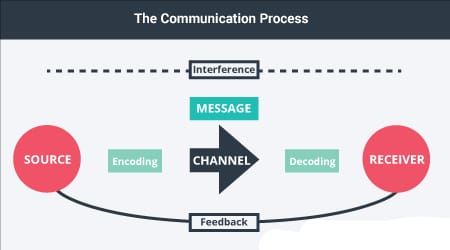
- 1) Source
- Source is also known as sender or encoder. The sender originates or generates the message i.e. initiates the communication, starts the communication. Thus the process of communication starts from the sender.
- 2) Message
- Message is the second element of communication. The content or information that is given during communication is known as ‘message’. Encoding is a type of process in which thought is converted into a communicable form. Such as word, symbol, gesture
- 3) Encoding
- Encoding is a process in which the sender converts his thoughts, ideas and feelings into a communicable form such as word, symbol, gesture
- 4) Channel
- The medium through which the message is transmitted or conveyed is known as the ‘channel’. Spoken word, written text, mail
- 5) Reciever
- The person who receives the message is known as the ‘receiver’. The receiver receives the message given by the sender and interprets it, i.e. decodes it. The receiver interprets the given message based on his knowledge, attitude, communication skills and socio-cultural system, that is, the receiver decodes the given message.
- 6) Decoding
- Decoding is a process in which the receiver interprets and understands the message he receives.
- 7) Feedback
- The response or reply given by the receiver to the sender is known as feedback. Feedback is the backbone of effective communication.
- 8) Context
- The environment or situation in which communication takes place is known as context. Context includes factors such as cultural background, the relationship between communicators, and specific circumstances.
- 9) Noise
- Noise is a type of interference that affects the clarity and reception of a message and disrupts and distorts it. Such as physical noise, background music, language barriers, misunderstandings, etc.

Types of communication

- Communication is divided into many types, which are as follows:
✓ Based on style and purpose / organizional structure
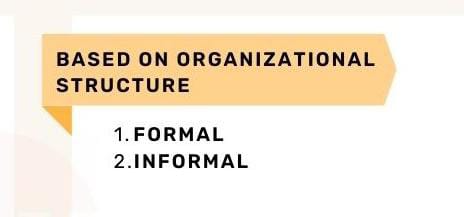
- 1) Formal communication
2) Informal communication - 1) Formal communication:
- Formal communication is also known as ‘official communication’. The official information exchanged between people holding different or similar positions in the same or other organization (such as hospital, school, college) is known as formal communication. In formal communication, information is shared objectively and professionally. In which slang, casual language and personal opinions are avoided. Formal communication includes official letters, reports, emails. Formal communication is mostly seen in written form. For example, the communication seen between a nursing superintendent and a staff nurse.
- 2) Informal communication:
- Informal communication is also known as ‘unofficial communication’. In informal communication, information, ideas and feelings are exchanged causally and spontaneously between individuals or groups. Such people are connected to each other through social relationships rather than formal channels. Informal communication includes gossip, small talk, phone calls, informal emails. For example, the interaction seen between two close friends, colleagues.
- ✓ Based on communication channel
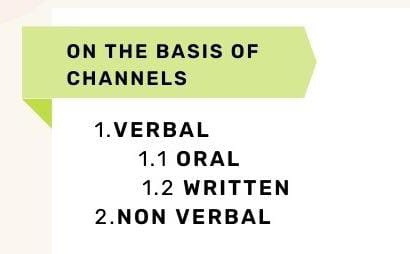
- 1) Verbal communication
2) Nonverbal communication
1) Verbal communication: - In verbal communication, ideas or information are shared through words and language. Which is found in spoken orally as well as written form.
- Which includes face to face conversation, telephone call, video call etc.
- In verbal communication, elements like words, voice tone, pitch, volume, inflection, grunt etc. are found.
- The following aspects are found in verbal communication:
- Articulation
- Articulation means pronunciation. Pronouncing a word or phrase clearly.
- Clarity:
- The message conveyed should be simple and clear. So that confusion can be minimized.
- Vocabulary:
- For effective communication, a person needs to have a good vocabulary so that the message can be conveyed well.
- Pacing:
- Use pauses at the right time while communicating. So that the sentence can be understood well.
- Simplicity:
- For effective communication, use simple language and words that can be easily understood. So that effective communication can be done.
- Confidence:
- Have confidence while conveying the message.
- Non verbal cues
- Use verbal cues like body language, facial expression, eye contact during communication. So that communication can be enhanced.
- Adaptability:
- Modify the spoken message according to the client’s behavior. This type of adjustment is known as adaptability.
- 2) Non verbal communication:
- In non verbal communication, the message is conveyed without using words. Understanding and interpreting non verbal communication is very important for effective communication and relationship building. Because with its help, one can know about the emotions, attitudes, and intentions of the other person. Non-verbal communication includes many methods such as body language, facial expression, gesture, posture, eye contact.
- Body language:
- Body language means physical language. The way we move or position our body expresses our feelings or intentions to a large extent and helps us communicate. For example, crossed arms suggest discomfort and defensiveness, while an open gesture suggests openness.
- Facial expressions:
- Our face expresses countless emotions. Of which we are not even aware. Such as smiling. Such facial movements convey our emotions. That is, with the help of facial expressions, the emotions of the other person can be known. Such as happiness😁, sadness😢, anger😡, surprise😮.
- Gesture:
- Gesture means gesture. In gestures, something is explained with the help of hand movements or other parts of the body. That is, with the help of gestures, a message can be conveyed or what we want to say can be explained to the other person. In which gestures like eye movements, head nodding, raising hand or finger are used. For example, the face is turned up and down, which means that the person in front wants to say ‘yes’. Also, the face is turned side to side, which shows that the person in front wants to say ‘no’. Thus, we use gestures in our daily life.
- Posture:
- The way we sit and stand reflects our feelings and attitude. For example, slouching indicates boredom and disinterest in something. While an upright position indicates attention and engagement.
- Eye contact:
- Eye contact during communication indicates many things. Maintaining eye contact during communication shows a person’s confidence, honesty and willingness. While avoiding eye contact during communication indicates nervousness, anxiety, discomfort.
- Touch:
- Physical contact such as handshakes, hugs and pats on the back (appreciation) etc. shows support, affection and formality. Different types of touch are seen according to cultural norms.
- Appearance:
- Clothing, grooming, dressing, hygiene and overall appearance provide information about a person’s personality, financial status, professionalism, culture, religion and overall appearance of a person provides information about his health status.
- ✓ Based on the basis of direction / flow
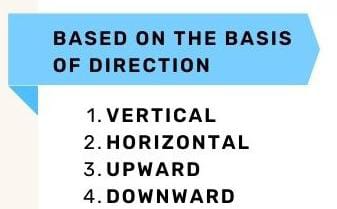
- 1) Upward communication
2) Downward communication
3) Horizontal communication
4) Vertical communication - 1) Upward communication
- In upward communication, communication is seen from bottom to top. Which is seen in the form of suggestions, complaints and reports. For example, a staff nurse gives suggestions to the nursing superintendent for quality care.
- 2) Downward communication
- In downward communication, communication is seen from top to bottom, i.e. from superior to subcoordinator. Which is seen in the form of orders, instructions. For example, a nursing superintendent gives instructions to his staff members about hospital policies, rules and regulations.
- 3) Horizontal communication
- Communication seen among individuals of the same level is known as horizontal or lateral communication. Such as the communication seen between two staff nurses, the communication seen between two collegians.
- 4) Vertical communication
- Vertical communication is basically formal communication which is seen from top to bottom or bottom to top.
- Level of communication
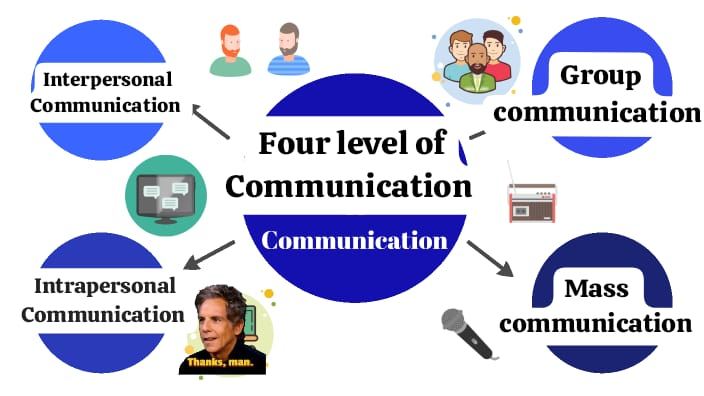
- 1) Intrapersonal communication
- In intrapersonal communication, a person communicates with himself, i.e. self-talk is seen. Which includes thoughts, feelings and self-reflection.
- 2) Interpersonal communication
- Interpersonal communication is seen between two people, i.e. one-to-one communication is seen. In which methods like conservation, phone call, video call etc. are used.
- 3) Group communication
- Group communication is the communication between three or more people. It can be face to face or through other communication mediums. Such as conference calls, meetings, discussions.
- 4) Mass communication
- In mass communication, information is shared and exchanged among a large population or audience through mass media. Such as television, radio, social media.
- Mode of communication

- Mode means a type of way of communicating. Which is verbal or non-verbal. There are mainly two modes of communication which are as follows:
- 1) Verbal communication
- 2) Nonverbal communication

- 1) Verbal communication
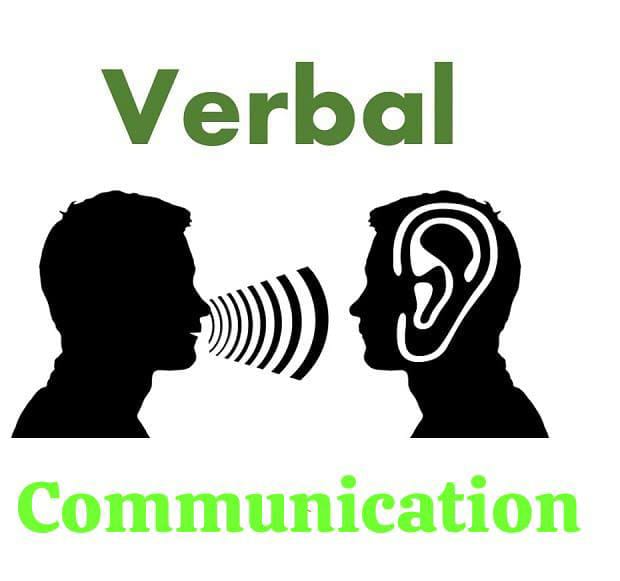
- Verbal communication is the sharing of ideas or information through words and language. Which is seen in spoken or written form.
- Which includes face to face conversation, telephone call, video call etc.
- Elements like words, voice tone, pitch, volume, inflection, grunt etc. are seen in verbal communication.
- The following aspects are seen in verbal communication:
- Articulation
- Articulation means pronunciation. Pronouncing a word or phrase clearly.
- Clarity
- The message conveyed should be simple and clear. So that confusion can be minimized.
- Vocabulary
- For effective communication, a person needs to have a good vocabulary so that the message can be conveyed well.
- Pacing
- Use pauses at the right time while communicating. So that the sentence can be understood well.
- Simplicity
- For effective communication, use simple language and words that can be easily understood. So that effective communication can be done.
- Confidence
- Keep confidence while conveying the message.
- Non verbal cues
- Use verbal cues like body language, facial expression, eye contact during communication. So that communication can be enhanced.
- Adaptability
- Modifying the spoken message according to the client’s behavior. This type of adjustment is known as adaptability.
- 2) Non verbal communication:
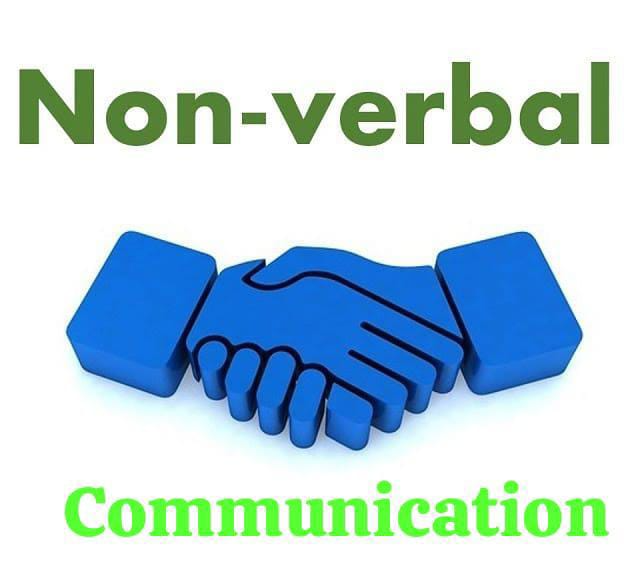
- In non-verbal communication, the message is conveyed without using words. Understanding and interpreting non-verbal communication is very important for effective communication and relationship building. Because with its help, one can know about the emotions, attitude and intention of the other person. Non-verbal communication includes many methods such as body language, facial expression, gesture, posture, eye contact.
- Body language:
- Body language means physical language. The way we move or position our body expresses our feelings or intentions to a large extent and helps in communicating. For example, crossed arms suggest discomfort and defensiveness while open gestures suggest openness.
- Facial expressions:
- Our face expresses countless emotions. Which we are not even aware of. Such as smiling. Such facial movements convey our emotions. That is, with the help of facial expressions, the emotions of the other person can be known. Such as happiness😁, sadness😢, anger😡, surprise😮.
- Gesture:
- Gesture means gesture. In gestures, something is explained with the help of hand movements or other parts of the body. That is, with the help of gestures, a message can be conveyed or what we want to say can be explained to the other person. In which gestures like eye movements, head nodding, raising hand or finger are used. For example, turning the face up and down indicates that the person in front wants to say ‘yes’. Similarly, turning the face side to side indicates that the person in front wants to say ‘no’. Thus, we use gestures in our daily lives.
- Posture:
- The way we sit and stand reflects our feelings and attitude. For example, slouching indicates boredom and disinterest in something. While an upright position indicates attention and engagement.
- Eye contact:
- Eye contact during communication indicates many things. Maintaining eye contact during communication shows the confidence, honesty and willingness of the person. Avoiding eye contact during communication indicates nervousness, anxiety, and discomfort.
- Touch:
- Physical contact such as handshakes, hugs, and pats on the back (appreciation) show support, affection, and formality. Touch can be seen in different ways depending on cultural norms.
- Appearance:
- Clothing, grooming, dressing, hygiene, and overall appearance provide information about a person’s personality, financial status, professionalism, culture, and religion. Overall appearance provides information about a person’s health status.
- Write down skill for effective communication
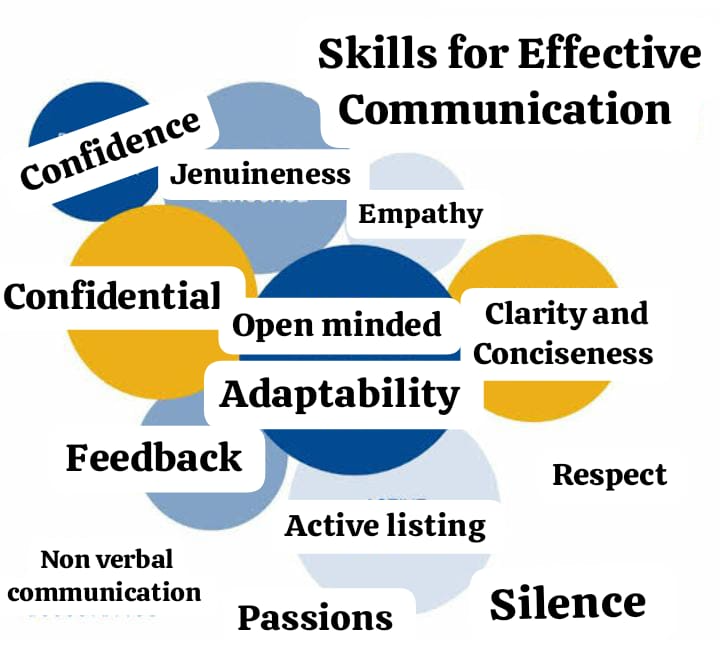
- Therapeutic communication is a fundamental skill in health care and counseling. Its main purpose is to improve the well-being of the patient and foster the therapeutic relationship. The key principles of therapeutic communication are as follows:
- Active listening:
- When the patient is talking to us, we should listen to the patient with full concentration and remember the words spoken by the patient. Then we should fully understand his message and then give a thoughtful answer.
- Empathy:
- Show sensitivity and sympathy towards the patient’s feelings and experiences. So that the patient can express his feelings well. Empathy helps in building trust and rapport.
- Respect:
- To respect the patient’s needs, choices, opinions and values as well as their culture. To respect the patient’s autonomy.
- Genuineness:
- To be authentic and senior during the interaction. Because patients trust genuine health care more.
- Clarity and Conciseness:
- To use clear words and understandable words while communicating. Do not use medical language. Also, use short sentences during communication.
- Confidential:
- To keep the information given by the patient secret. Do not share it with anyone. That is, to be confidential.
- Confidence:
- Be confident while communicating. So that the patient trusts us.
- Feedback:
- Provide systematic feedback to the patient. Also receive systematic feedback from the patient. So that the communication becomes effective.
- Adaptability:
- Adjust our communication style according to the patient and adapt the patient’s communication style. So that the communication becomes more effective and relatable.
- Open-minded:
- Use open-ended questions instead of closed-ended questions during communication. So that the patient can explain his/her feelings and thoughts well and more information about the patient can be obtained.
- Non-verbal communication:
- Pay attention to the patient’s body language, facial expressions, and other non-verbal cues. This can provide additional information about the patient’s emotional state.
- Silence:
- Listen to the patient calmly while he or she is talking. Avoid interrupting, i.e., remain silent.
- Patience:
- Maintain patience when dealing with complex or sensitive topics. Give the patient time to fully express his or her thoughts.
- The above skills are essential for effective communication.
- Write down barriers to communication
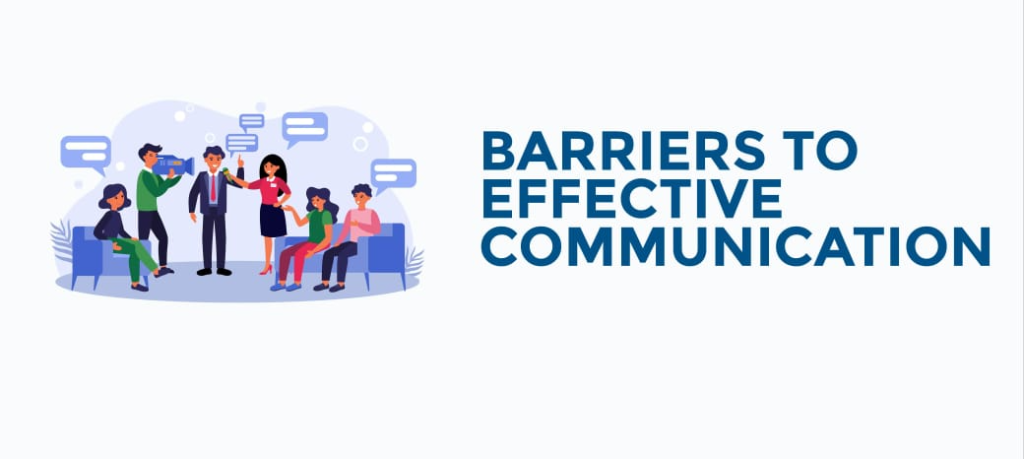
- Barrier means obstacle. There are many barriers in communication due to which the process of communication gets altered. The message is not conveyed in the same way. The following barriers are found in communication:
- ✓ Physiological barrier:
- Difficulty in hearing (auditory deficit)
- Difficulty in vision (visual deficit)
- Sensory deficit
- Difficulty in expression
- Difficulty in palpitation
- ✓ Psychological barrier:
- Lack of motivation
- Stress, anxiety or emotional disturbance
- Lack of attention and interest
- Level of intelligence
- Prejudice, bias and stereotypes
- ✓ Environmental barrier:
- Lack of ventilation
- Lack of light
- Lack of privacy
- Extreme temperature
- Extreme Noise
- Congestion
- ✓ Organizational Barrier:
- Organizational Attitude
- Organizational Rules and Regulations
- Inadequate Organizational Facility
- Noise
- Inadequate or Unclear Communication Channel
- ✓ Cultural Barrier:
- Personality Trait
- Customs
- Religion
- Belief
- Attitude
- Importance of Communication in Health
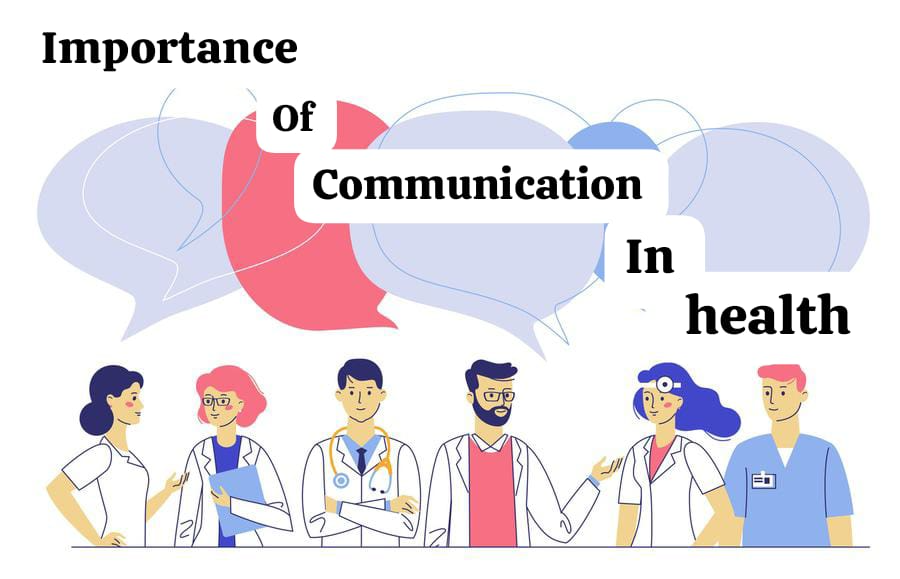
- Effective communication is very important in health care.
- Accurate diagnosis
- Clear communication is very important for the health care provider to understand the subjective data of the patient, due to which an accurate diagnosis can be made.
- Education
- With the help of communication, health education can be provided to the patient. For example, providing education about family planning to a newly married couple.
- Motivation
- A person can be motivated through communication. For example, a person can be motivated to maintain a healthy lifestyle.
- Reducing medical errors
- Due to effective communication between health care providers, medical errors can be prevented and accurate care can be provided.
- Counselling
- Any person can be counseled with the help of communication. Counseling can change a person’s behavior.
- Psychological support
- Effective communication is useful for providing psychological support to the patient. So that the patient’s tension and stress can be reduced.
Published
Categorized as GNM-FUNDAMENTAL-FULL COURSE, Uncategorised